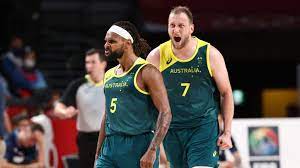

Jenaro Díaz breaks down in detail, in a series of chapters, all the aspects of Australia’s game that have made them a dream team that won bronze at the Tokyo 2020 Olympic Games. With this series we begin a project with which we want to improve the understanding of the game and that you can learn to better see the game of basketball.
We have created a kind of game, as a challenge for you to self-evaluate your ability to learn how to watch basketball, which has the following phases:
a) We will start a small video cut
b) We will ask you some questions
c) Subsequently we will offer you the analyzed video
d) Finally, we will break down the details that Jenaro Díaz considers most interesting to extract from the video.
Comencemos:Comencemos:
Here is a very short 28-second clip of Australia’s defense against the USA.
Here are some questions that may help you to see other details:
In this same, slower cut, we can see in 90 seconds many details of this action.
What percentage matches what you have seen?
The following is a comic book breakdown of the stills and their comments that Jenaro Díaz has seen in these actions.
PROTECT THE CASTLE

“Avoid advancing the ball to put pressure on it. Balance and defense is a teamwork and communication. The war is to stop the ball in order to put pressure on it later.”
When a USA player dribbles, we jump on the ball and they collapse the zone.

When there is no contact, they give distance on blocks. They do not wear themselves out in assists and are in visual contact with their attacker when defending cuts or blocks.

The pick defense lasts as long as the blocking time and its recoveries. Watch out for the options where the player does not bounce and has all the passing possibilities.

If the ball is on the ground, the team enters to assist the bounce.

In the Close out look at the feet of the attacker, as it indicates what the player is going to do. If he is a finisher, they will switch and pass the ball, to recover quickly and jump a lot. If he is a creator, collapse more and allow more time to shoot.

When the attacker splits with a bounce, force him to stop to deny the pass again when he catches the ball.

Punish bad spacing by collapsing the area.

Pitches are tap to the maximum, always arriving.

After the opponent’s shoot, you have to win the rebound, for that you have to be more and, above all, think about always offense.

In this idea of always offense, the one who has thrown you, finishing without pivots, fast, to take advantage of the unexpected factor.

Everything adds up, including the attitude from the bench. A lively bench, which sows emotion and encourages those on the court to make an effort, involving everyone in a common goal.

Related Posts
n the last three years, Sportcoach has been positioned itself as a reference developing content for coaches. First in Basketball,
By Brianna Finch, Assistant Women’s Basketball Coach Boston University. She shares her approach to Practice Design and Planning through her
